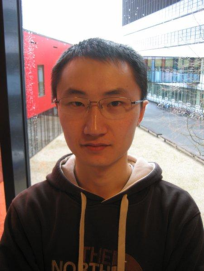Inorganic-organic hybrid electronics
Promotion date: 28-10-2011
Promotors: Prof. dr. ir. Wilfred van der Wiel
Prof. dr. ing. Dave Blank
| Organic building blocks are increasingly applied in current nano-electronics research and development. In this thesis, the hybrid organic-inorganic magnetically active systems at various size and dimensionality were investigated. Several molecular approaches were developed to assemble magnetic nanoparticles on various substrates with controllable density. This is considered as a step forward towards nanoparticle based hybrid spintronics devices. A novel, facile molecular fabrication method for inserting isolated localized magnetic moments in a metal film with tunable density was also presented. This offered a model system to study the mutual interaction of localized magnetic moments and their interplay with itinerant conduction electrons.
|
What new approach did you choose in your research project?
As silicon-based electronics approach the limit of improving performances and capacity through dimensional downscaling, attention in nanoelectronics is turned towards building blocks that are very different from materials in conventional semiconductor industries. Hybrid systems consisting of organic/inorganic materials building blocks, are highly promising thus extensively studied in my thesis project.
For instance, we inserted isolated localized magnetic moments in a metal film with tuneable density by a novel molecular fabrication approach. The resulting hybrid organic/inorganic system offered us new understanding on the mutual interaction of localized magnetic moments and their interplay with itinerant conduction electrons.
Do you recall some specific moments during your PhD?
Around the end of the second year of my PhD project, I was beginning to feel the big picture of my project. Then I could carry on the research more in depth and detail, with confidence.
Along the way I developed a nice philosophy and logic regarding the field of research, and came up with interesting new findings.
How did you develop as a scientist and person?
I was more of a chemist and material scientist in the beginning. With this highly multidisciplinary PhD project - involving surface chemistry, quantum physics, nano magnetism and nano fabrication - I greatly broadened my knowledge and enjoyed very much working beyond the boundaries of scientific fields.
Also, I learned a lot by transforming a new cryostat for transport-measurement at extremely low temperatures to a really useful new R&D tool for our group. Both, experts from the University of Twente and experts from other universities, helped me to accomplish this challenging project.
This system is able to measure a signal of tenth of nanovolts at temperatures near absolute zero. This cryogenic system made our group ‘the coolest place at Twente’. This initiative of my supervisor professor Wilfred van der Wiel opens new possibilities for our group but also for our close collaborators at MESA+. This, of course, is a good thing for the institute.
Did you manage to have some nice publications?
Sure, I published in Nano Letters, in the Journal of Materials Chemistry and in Langmuir. Apart from journal papers, I was an invited speaker in a parallel section on the 26th International Conference on Low Temperature Physics (2011). Furthermore, I was speaker at SPINOS III in Amsterdam (2010) and at the 53th Annual Conference on Magnetism and Magnetic Materials (2008). At the beginning of next year I will present my work on the Physics@FOM conference in Veldhoven.
What are your future plans?
Right now, I am working as a post-doc researcher, with a double aim: to further deepen the thesis research and to introduce successors to the field of knowledge, and also get them acquainted with the cryogenic measurement apparatus. They will continue the fascinating investigation on the hybrid organic-inorganic electronics at nano-scale. After that I would like to start working in industry, favourably at the Netherlands. I would like to contribute to the development of technology enabled solutions, so people can benefit more from the work I have done.
What, in your opinion, is important for MESA+ to stay successful in future?
The internal calibration between the groups at MESA+ could be quite pleasant and fruitful. I collaborated with colleagues from several groups at MESA+: the Interfaces and Correlated Electron systems group (ICE) of professor Hans Hilgenkamp, the Molecular Nanofabrication group (MnF) of professor Jurriaan Huskens and the Inorganic Materials Science group (IMS) of professor Dave Blank.
Set up grants for talented post-doc researchers could be a good thing for MESA+. They are highly skilful and they can bring in and realize new ideas at a good level and in a relatively short period of time.
Besides research skills, project/ time management skills can be very useful for PhD candidates at MESA+.

